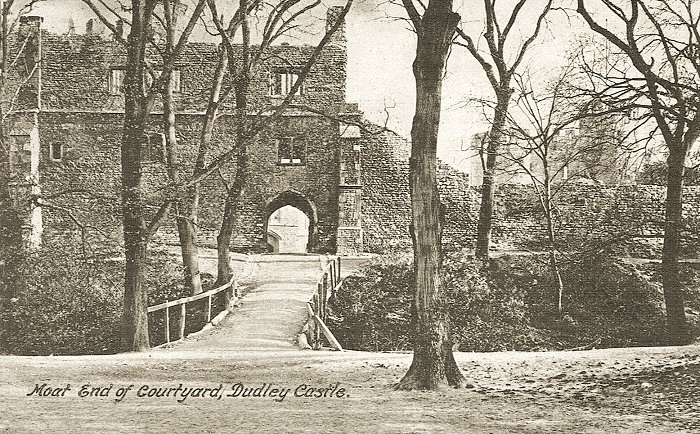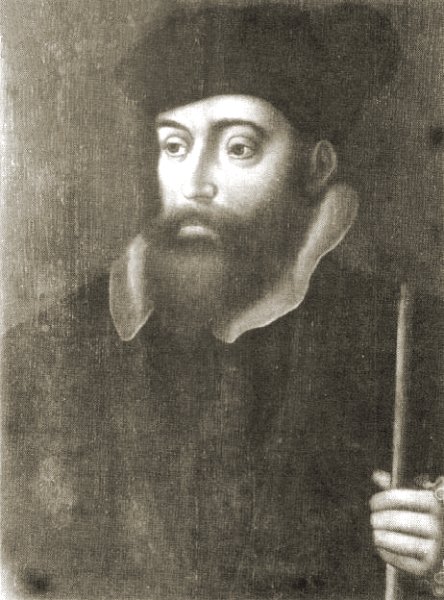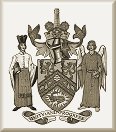| More about the de Sutton family
John de Sutton 5th was succeeded by his son, John 6th,
who was born on the 25th December, 1400 at Dudley
Castle. In about 1420 he married Elizabeth Berkley, and
they had eight children:
|
Catherine, born in 1421 |
|
Edmund, born in 1425, died in 1488 |
| John,
born in 1427, died in 1503 |
|
Margaret, born in 1429, died in 1457 |
|
William, born in 1431, died in 1483 |
|
Jane,
born in 1434, died in 1494 |
|
Oliver, born in 1437, died in 1469 |
|
Eleanor, born in 1439, died in 1513 |
John 6th is believed to have served
for some time under Humphrey Duke of Gloucester, in Guînes Castle in France. He carried the standard at the
funeral of Henry V in 1422 and became Knight of the
Garter. In 1428 he was appointed Treasurer of the King’s
Household and also Viceroy of Ireland, a post he
held for two years.
In 1439 he was summoned to
Parliament, which was then held at Reading, where he
obtained a Barony by writ as Lord Dudley and became
the first of the family to adopt the surname Dudley.
In 1443 he was made a King’s Councillor and became
one of King Henry VI’s favourite companions. In 1444
he was granted £100 by the king for his services.
John also undertook diplomatic missions with
the Bishop of Chichester, to the Duke of Brittany
and the Duke of Bergundy. In 1451 was made a
Knight of the Garter.
During the Wars of the Roses, between 1455 and 1487
between supporters of the royal House of Plantagenet (the House of Lancaster,
represented by a red rose) and the House of York (represented by a white rose), Lord Dudley was
initially one of the most enthusiastic fighters for
the Lancastrian cause. He was taken prisoner at
Gloucester in 1451 and at the battle of St. Albans
on the 21st May, 1455. During the battle he was
assisted by his son Edmund and was taken prisoner
along with Henry VI. Lord Dudley was sent to the
Tower of London, and released by 1459 when he took
part in the battle of Blore Heath, on the 23rd
September, 1459, again assisted by his son Edmund.
He commanded a wing under Lord Audley and was
wounded and taken prisoner.
|
|

From an old postcard. |
|
In 1460 Lord Dudley was elected
as a Knight of the Garter and after his release, he
quietly changed his allegiance to the House of York.
At the Battle of Towton in 1461 he was rewarded
for his participation on the side
of Edward, Earl of March, son of Richard, Duke of
York. On the 28th June that year, Edward IV was
proclaimed King in London and Lord Dudley became
Constable of the Tower of London.
Ex-King Henry was captured by Edward's
forces in 1465 and imprisoned in the Tower of
London. Henry was restored to the throne in 1470, but
Edward took over again in 1471, killing Henry's only
son and heir, Edward of Westminster, in battle and
imprisoned Henry once again. Henry died in the Tower
of London during the night of the 21st May, 1471,
possibly killed on the orders of King Edward.
In 1477 to 1478, Lord Dudley
was in France with his brother-in-law, the Earl of
Arundel to negotiate the continuance of the peace
treaty between England and France. In 1479, Lord
Dudley’s wife, Elizabeth, died, and in 1483 his
eldest son Edmund, also died. After King Edward’s
death in 1483, Lord Dudley supported the new ruler,
King Henry VII, the first monarch from the House of
Tudor. Lord Dudley was given the manors of
Northfield and Wiley, in Worcestershire and created
Sheriff of Sussex after his part in the Battle of
Bosworth Field, the last significant battle in the
Wars of the Roses.
Lord Dudley died on the 30th
September, 1487 at Dudley Castle. His will stated
that he was to be buried in St. James Priory,
Dudley, in a tomb costing no more than £20. Because
his eldest son, Edmund, died before him, the barony
was inherited by Edmund’s son, Edward.
Sir Edward Sutton, 2nd Baron
Dudley, was born around 1460 and married Cicely
Willoughby of Parham, at Worcester, on April 21st,
1478. She was just 15 years old. They had 15
children:
|
Eleanor, born in 1481, died in 1526,
Countess of Worcester |
|
Margaret, born in 1485, died 1525 |
|
Jane born in 1487, died in 1539 |
|
William, born in 1489, died in 1504 |
|
Katherine, born in 1490, died in 1572 |
|
Joyce, born in 1492, died in 1586 |
|
Margaret, born in 1492, died in 1563 |
|
Dorothy, born in 1493, died in 1525 |
|
Elizabeth, born in 1493, died in 1544,
Lady Butler |
|
John, born in 1494, died in 1553, 3rd
Baron Dudley |
|
Thomas, died in 1499, died in 1549 |
|
Constance, born and died in 1501 |
|
Joan, born in 1504, died in 1555,
Countess Ormond |
|
Arthur, born in 1505, died in 1576 |
|
Geoffrey, born in 1507, died in 1571 |
|
Cicely Willoughby died on the
1st August, 1539 |
Edward Sutton’s mother was
Joyce de Tiptoft, daughter of Sir John Tiptoft, 1st
Baron Tiptoft. She died on the 18th October, 1485 in
Dudley Castle. Edward benefited from his mother’s
inheritance of the Tiptoft barony and also the
Cherleton barony. He was elected as Knight of the
Garter in the beginning of King Henry VIII's reign
and was chamberlain to Princess Mary (later Queen
Mary I) from 1525 to 1528.
Sir Edward Sutton, 2nd Baron
Dudley, died on the 31st January, 1531 was succeeded
by his son John, who was born in 1494 at Dudley
Castle. By the 30th October, 1501 John was betrothed
to Lady Cecily Grey, daughter of the 1st Marquess of
Dorset. They married in about 1512 and had the
following children:
|
Edward, born in 1512, died 1586, 4th
Baron Dudley |
|
Henry, born in 1517, died 1570 |
|
George, born in 1519, died 1560 |
|
Margaret |
|
Thomas |
|
Dorothy |
|
Elizabeth |
|
Robert |
John Sutton, 3rd Baron Dudley,
was knighted on the 13th October, 1513, and became
known as Lord Quondam, or Lord Has-been. He was in
debt and mortgaged most of his estates to Sir John
Dudley, afterwards Duke of Northumberland, for
£2,000, for which he agreed to pay £400 yearly.
In 1532 Baron Dudley wrote to
Cromwell begging him to use his influence with the
king to persuade him to pay the £2,000 and to take
in exchange the manor of Sedgley,
worth £180 per year, for twenty years. The request was
not granted and in 1553 he begged Cromwell to pay
the £400 interest. In 1538 or 1539, Cromwell lent
him £1,000. In 1535 He sold Dudley Castle
and the manor of Dudley to his cousin, Sir John
Dudley, who resided at the castle and added many
extensions including the rebuilding of the whole
residential block on the east side of the bailey. |
|
John Sutton sold off much of
his inheritance including buildings and estates. He
lost almost everything and had to rely on the
charity of his friends, sometimes relying on them
for accommodation during many visits.
His wife
Cicely and one of her daughters found refuge at
Nuneaton, where the prioress gave them meat and
drink free of charge. John eventually obtained a
residence in Tothill Street, Westminster.
He died in Middlesex, in 1553
and was buried in St Margaret's Church, Westminster,
on the 18th September. His wife Cecily died in 1554
and was also buried there, on the 28th April.
Ironically, John Dudley, Earl of Warwick and Duke of
Northumberland was beheaded on Tower Hill on the
22nd August 1553 for attempting to put his
daughter-in-law, Lady Jane Grey, on the throne in
place of Mary I. Two of his friends, Sir John Gates
and Sir Thomas Palmer were also executed on the same
day, for supporting him.
|

Sir John Dudley, Duke of
Northumberland. |
|
After Northumberland's
execution, Dudley Castle became crown property and
in 1555 Queen Mary handed it over to Edward Sutton,
4th Baron Dudley. Edward was born in 1512 and
obtained a commission as captain under his uncle
Lord Leonard Grey in Ireland. In 1547 he joined the
expedition into Scotland and was appointed governor
of Hume Castle. He was a distinguished soldier who
managed to regain the family estates.
He succeeded
his father as Lord Dudley in 1553 and had three
wives. The first was Katherine Brydges, daughter of
John Brydges. They were married in 1556 and had two
children, Anne, born in 1556, died in 1605, and
Thomas. The following year after Katherine’s death
in 1566, Edward married Jane Stanley, daughter of
Edward Stanley, 3rd Earl of Derby. They had two children, Edward Dudley, who became the
5th Baron Dudley, born on the 17th September, 1567,
died on the 23rd June, 1643, and John Dudley, born
on the 30th November, 1569, died in 1644 or 1645.
After Jane’s death he married Mary Howard, daughter
of William, 1st Baron Howard, on the 16th December,
1571 at Whitehall Palace.
Mary Queen of Scots was forced
to abdicate in 1567 and fled to England to seek the
protection of her first cousin once removed, Queen
Elizabeth I of England. Perceiving Mary as a threat,
Elizabeth had her confined in various castles and
manor houses in England. In 1575 Queen Elizabeth
visited Dudley Castle. Possibly because the old
great chamber had been converted into a spacious drawing
room with two large double transomed six-light
windows.
In 1585 Dudley Castle was
considered to be suitable for use as a prison for
Mary and so her jailer, Sir Amias Paulet, inspected
the castle and decided that it was unsuitable for
the purpose. He reported that there were not enough
rooms, tables, cupboards and stools. Coal and wood
was plentiful but had to be purchased and a barn would
have to be converted to a stable for the horses. There were no inner chambers for servants, or staff,
brewing vessels were decayed, the water supply had
to come from outside the castle, and security could
be a problem because some of the windows the
surrounding park. He felt that the deep ditch would
prevent her from escaping and that the buildings
were very strong. In the end she was sent to the moated manor house at Chartley.
Edward Lord Dudley died in 1586
and was succeeded by his eldest son, also called
Edward. Edward Dudley 5th Baron Dudley, was born on
the 17th September, 1567. In 1580, at the age of 13,
he was sent to Lincoln College, Oxford, and the
following year married Theodosia Harington
(1560 to 1650) of Exton,
Rutland, who was about 5 years older. Theodosia
Harington, who died in 1649 was the daughter of
James Harington of Exton, Rutland, a lawyer and
long-serving MP.
The Harington
family were the largest landowners in Rutland.
Edward and Theodosia Sutton had
one son and four daughters:
| Ferdinando, born in
1588, died in 1621. Married Honora Seymour, daughter
of Edward Seymour. |
| Mary, born in
1586, died in 1645. |
| Anne, born in
1589, died in 1615. |
| Margaret, born
in 1597. |
| Theodosia,
born in 1599, died in 1615. |
Edward also had a
mistress, Elizabeth Tomlinson, with whom he had at
least 12 illegitimate children, who he provided for.
Elizabeth Tomlinson (1579 to 1629) was the
daughter of local collier William Tomlinson and his
wife Agnes. Their children were as follows:
Robert, born in
1587, died in 1653.
Married Margaret. |
|
Susan, born in 1594, died in 1601. |
|
Elizabeth, born in
1588, died in 1647. Married Jeffrey
Dudley. |
|
John, born in 1597, died in 1604. |
|
Jane, born in
1588. Married Richard Parkhouse. |
|
Dud, born in 1600, died in 1684. Married
Eleanor Heaton, 1606 to 1675 then
married again. |
|
Catherine, born in
1589, died in 1675. Married Thomas
Dudley. |
|
Dorothy, born in 1606. Married Thomas
Brooke. |
|
Martha, born in
1590. Married Thomas Wilmer. |
|
Eleanor, born in 1606, died in 1659. |
|
Alice Dudley, born
in 1592. Married George Guest. |
|
Edward, born in 1608, died in 1614. |
The
eldest child, Robert, was given a small
estate at Netherton; Dud, an ironmaster, was given
the lease of Chasepool Lodge in Swindon,
Staffordshire;
Jane, was grandmother to ironmaster Abraham Darby I.
Edward owned lands in
Staffordshire and Worcestershire, as well as the
manors of Dudley, Sedgley and Kingswinford, along
with local ironworks.
| |
|
|
|
|
| Read about
early industries |
 |
|
Read about
Dud Dudley |
 |
| |
|
|
|
|
Edward moved to Himley Hall,
then a moated manor house, with
his mistress, Elizabeth Tomlinson and their children, leaving his
wife Theodosia and their children in London. Edward
left his wife with no financial support; the Privy
Council became involved and the Star Chamber ordered
Edward to pay his wife an allowance, as she was left
"without provision of sustenance" whilst he lived
with "a lewd and infamous woman".
Edward
continued to leave his wife without money and in
August 1597 was sent to Fleet Prison for non-payment
of the allowance. He was only imprisoned for a few days
and was released on condition that he give his
wife the £66 that was owed to her since the Privy
Council ruling. In addition to this, he was to pay
£100 a year to Theodosia during her lifetime unless
the couple were to reunite, as well as £10 a year
for the education of each legitimate child. Less
than eighteen months later Edward was again called
to the Privy Council as he had failed to maintain
the payments, sending Theodosia only one payment of £32.
Edward Dudley was knighted in
1584 but did not take his seat in the House of Lords
until 1593. Lord Dudley ended-up in the
Star Chamber, the court which sat at the royal
Palace of Westminster.
Debts continued to grow, and by
1593 the estate had been forcibly possessed by the
authorities. He fell out with his younger brother
John, because Lord Dudley failed to pay him a
promised annuity from their father’s estate.
Dudley’s most bitter feud was with Gilbert Lyttelton,
in the 1590s, over Prestwood Farm. He had Lyttelton
forcibly removed and claimed the right to seize
goods from Lyttelton’s estates and took sheep and
cattle. He also claimed one of Lyttelton's coal
mines, had the miners arrested, and confiscated the
stocks of coal, before setting the mine on fire.
He was again summoned by the
Privy Council who tried to reason with him.
Lyttelton complained to the Star Chamber and Lord
Dudley was heavily fined for rioting and cattle
rustling. He attempted to revenge Gilbert Lyttelton
by blocking the election of his relative Edward
Littleton. This resulted in two of Gilbert Lyttelton's sons, Stephen and John, attacking Lord
Dudley and his retainers.
In 1597, Lord Dudley put his
brother John, as a candidate in an election, in an
attempt to stop the election of Sir Edward Littleton,
of Pillaton Hall, near Penkridge. Lord Dudley
ensured that there would be a blank return from his
father-in-law Thomas Whorwood, ensuring that
Littleton would loose. Bills were filed against Lord
Dudley and Thomas Whorwood in the Star Chamber, but
that parliament was nearly at an end, so no action
was taken. The scandal ensured that Lord Dudley
could have no further parliamentary career.
Lord Dudley was patron of group
of actors, known as Lord Dudley's players, who had a
performing bear. The company was led by Francis
Coffyn and Laurence Bradshaw, and in 1595 Lord
Dudley set up a warrant to allow the company to
travel and perform, but soon revoked the license in
favour of a different group. Because of his
unbalanced behaviour, he had widespread notoriety and
ensured the financial ruin of his family. He was the
last Sutton to bear the Dudley title.
Lord Dudley died on the 23rd June, 1643 and was
buried in St Edmund's Church, Dudley. His legitimate
son, Ferdinando, died of smallpox before his
father’s death. He had an only child, a daughter,
Frances, who married Humble Ward. His father,
William Ward, jeweller to Queen Henrietta Maria, and
a wealthy goldsmith, paid Lord Dudley's debts and
Frances Ward inherited the estates, becoming
Baroness Dudley.
Humble Ward became Lord Ward of
Birmingham in 1644. He was High Sheriff of
Staffordshire in 1658.
Humble Ward and Frances had eight
children:
|
Frances, born on
23rd July, 1611, died before August,
1697 |
|
Theodosia, baptised on 15th May,
1642 at St. Edmund's Church, Dudley,
died January, 1678 or 79. |
|
Anne born on the
12th February, 1629 |
|
John |
|
Edward, born in
1631, died in 1701, became the 2nd Baron
Ward |
|
Humble |
|
William, born
circa 1631, died 3rd August, 1701 |
|
Honor. |
Lord Ward, born in 1614, died on the 14th
October, 1670 and his son, Edward, became the 2nd
Baron Ward. Lord Ward’s wife, Frances, died on the
11th August, 1697.
|
 |
|
 |
|
 |
Return to the 12th
to 14th Century |
|
Return to
the contents |
|
Proceed to the Civil War |
|